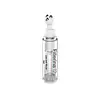What's inside
What's inside
 Key Ingredients
Key Ingredients

 Benefits
Benefits

 Concerns
Concerns

 Ingredients Side-by-side
Ingredients Side-by-side

Hydrogenated Polyisobutene
EmollientSqualane
EmollientPolyethylene
AbrasivePEG/PPG-36/41 Dimethyl Ether
Skin ConditioningDiphenylsiloxy Phenyl Trimethicone
Skin ConditioningEthylhexyl Methoxycinnamate
UV AbsorberMalic Acid
BufferingMicrocrystalline Wax
Emulsion StabilisingWater
Skin ConditioningAscorbyl Dipalmitate
AntioxidantDipropylene Glycol
HumectantPEG-10 Dimethicone
Skin ConditioningGlycerin
HumectantTocopherol
AntioxidantSimethicone
EmollientBHT
AntioxidantWater
Skin ConditioningGlycerin
HumectantHydrolyzed Glycosaminoglycans
HumectantSodium Hyaluronate
HumectantCaprylyl Glycol
EmollientHydrolyzed Elastin
EmollientSodium Hyaluronate Crosspolymer
HumectantPentylene Glycol
Skin ConditioningHydrolyzed Hyaluronic Acid
HumectantHydrolyzed Collagen
EmollientHyaluronic Acid
HumectantHydroxypropyl Cyclodextrin
MaskingTropolone
Skin ConditioningButylene Glycol
HumectantHydrolyzed Sodium Hyaluronate
Skin ConditioningCarbomer
Emulsion StabilisingDecylene Glycol
Skin Conditioning1,2-Hexanediol
Skin ConditioningPalmitoyl Tripeptide-38
Skin ConditioningLeuconostoc/Radish Root Ferment Filtrate
AntimicrobialArginine
MaskingSoluble Collagen
HumectantEthylhexylglycerin
Skin ConditioningSodium Chondroitin Sulfate
Skin ConditioningAcetyl Hexapeptide-30
Skin ConditioningAcetyl Hexapeptide-37
Skin ConditioningSodium Hydroxide
BufferingDisodium EDTA
Phenoxyethanol
PreservativeSodium Chloride
MaskingSorbic Acid
PreservativeSodium Benzoate
MaskingWater, Glycerin, Hydrolyzed Glycosaminoglycans, Sodium Hyaluronate, Caprylyl Glycol, Hydrolyzed Elastin, Sodium Hyaluronate Crosspolymer, Pentylene Glycol, Hydrolyzed Hyaluronic Acid, Hydrolyzed Collagen, Hyaluronic Acid, Hydroxypropyl Cyclodextrin, Tropolone, Butylene Glycol, Hydrolyzed Sodium Hyaluronate, Carbomer, Decylene Glycol, 1,2-Hexanediol, Palmitoyl Tripeptide-38, Leuconostoc/Radish Root Ferment Filtrate, Arginine, Soluble Collagen, Ethylhexylglycerin, Sodium Chondroitin Sulfate, Acetyl Hexapeptide-30, Acetyl Hexapeptide-37, Sodium Hydroxide, Disodium EDTA, Phenoxyethanol, Sodium Chloride, Sorbic Acid, Sodium Benzoate
Ingredients Explained
These ingredients are found in both products.
Ingredients higher up in an ingredient list are typically present in a larger amount.
Glycerin is already naturally found in your skin. It helps moisturize and protect your skin.
A study from 2016 found glycerin to be more effective as a humectant than AHAs and hyaluronic acid.
As a humectant, it helps the skin stay hydrated by pulling moisture to your skin. The low molecular weight of glycerin allows it to pull moisture into the deeper layers of your skin.
Hydrated skin improves your skin barrier; Your skin barrier helps protect against irritants and bacteria.
Glycerin has also been found to have antimicrobial and antiviral properties. Due to these properties, glycerin is often used in wound and burn treatments.
In cosmetics, glycerin is usually derived from plants such as soybean or palm. However, it can also be sourced from animals, such as tallow or animal fat.
This ingredient is organic, colorless, odorless, and non-toxic.
Glycerin is the name for this ingredient in American English. British English uses Glycerol/Glycerine.
Learn more about GlycerinWater. It's the most common cosmetic ingredient of all. You'll usually see it at the top of ingredient lists, meaning that it makes up the largest part of the product.
So why is it so popular? Water most often acts as a solvent - this means that it helps dissolve other ingredients into the formulation.
You'll also recognize water as that liquid we all need to stay alive. If you see this, drink a glass of water. Stay hydrated!
Learn more about Water